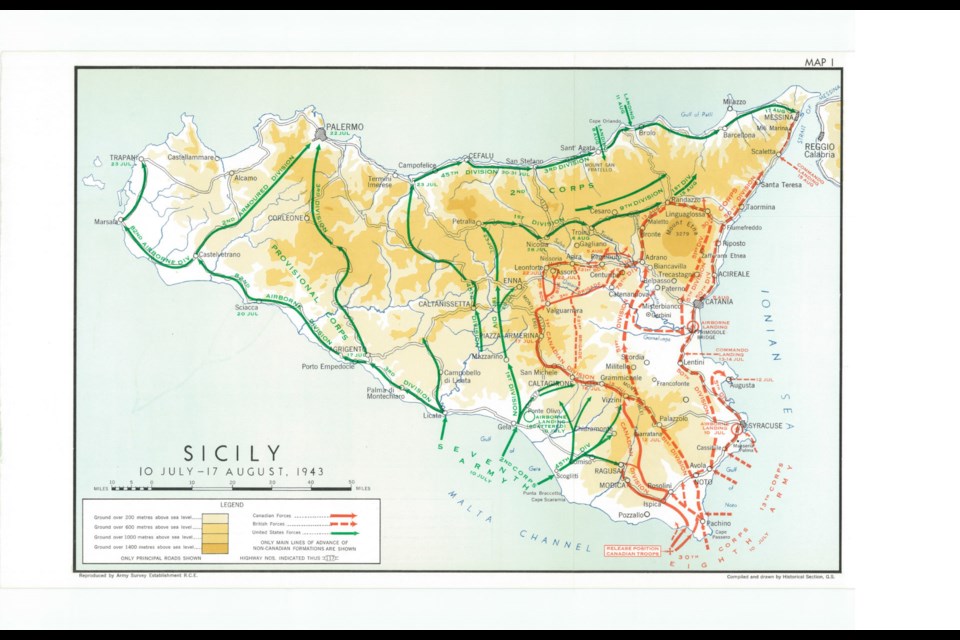Lance-Cpl. Gilbert John Hyde’s unit faced little enemy opposition after landing on Sicily’s beaches three days after the Allies’ main assault on the Mediterranean island, but the terror of war grew the farther inland they went.
Hyde, then 23, was the driver of a Bren Gun carrier in “A” squadron with the 4th Princess Louis Dragoon Guards (PLDG), a reconnaissance regiment. The Moose Jaw native enlisted on Oct. 18, 1938, at age 18 and trained in Canada and in England — he witnessed the Battle of Britain — before his unit sailed for the “underbelly of Europe” with the famed British Eighth Army.
Late arrivals
The Guards were supposed to hit the beach on July 10, 1943, as part of Operation Husky and reconnoitre the area with the infantry. However, by the time the squadron arrived — at only half strength — on July 13, the fighting had moved inland while a weak Italian coastal division offered no resistance.
“I think they were just glad to give up. … we off-loaded our vehicles and went about two or three miles inland and my introduction to war was that night,” Hyde recalled.
The unit bivouacked — or camped — behind a hill, and since it was pitch black, they didn’t know where they were.
Night terrors
“And about three o’clock in the morning, holy smokes we heard these guns going off, and this is the first time I’d really, you know, I’d heard artillery fire before because we’d done reconnaissance work … ,” he said.
A battery of 155-millimetre howitzers began shooting over their heads, but the soldiers realized it was friendly and was shooting toward the enemy. Hyde thought this was still scary, considering it was 3 a.m. and they were in a foreign country.
Reconnaissance begins
Hyde and his squadron packed up the next day and caught up to the advancing infantry, where his unit was instructed to inspect a nearby village. This mission was successful without casualties, but they wouldn’t all be like that.
A week after arriving, members of Hyde’s unit became casualties after German machine gun and mortar fire hit them.
“… I, myself, was still back with the commander,” recalled Hyde. “So, although we heard the shells and machine guns and that, we weren’t really under fire ourselves.”
Moving to Italy
After six weeks in Sicily, the PLDG crossed the Strait of Messina to mainland Italy.
Another infantry unit had landed before the Guards and cleared the way, which meant Hyde’s unit faced little opposition after landing at Reggio di Calabria on Sept. 3, 1943, on the west coast of Italy.
They then travelled south and up the east coast to Locri, where they ran into thousands of Italian soldiers intent on surrendering.
“… we see these guys coming out full marching order, swords, bayonets, flags, bands, a whole division coming down the road to us,” said Hyde. “And the general’s in front leading the parade, with all his medals and sashes and God knows what, and we just sort of waved them on, ‘Keep going boys, we can’t, we can’t do anything for ya.’”
Friendly fire
The Guards continued travelling north, with mountains on their left and the Ionian Sea on their right. At 10 a.m., a squadron of Allied Kittyhawk fighters screamed overhead and “strafed the living jee-zus” out of the unit.
The planes continued to strafe the Canadians for 10 more minutes despite the latter shooting flares to call off the attack. The attack destroyed two Bren Gun carriers, two armoured cars, killed two men and injured five.
“We just dove under our carriers and trucks and just prayed to God that, you know, nothing would happen to us,” the Moose Javian said.
Ten minutes later, German Messerschmitt 109s planes flew overhead and waggled their wings before flying off. Hyde believes the aircraft didn’t attack because they likely believed the unit was German.
Little Stalingrad
After several months of fighting, the Canadians arrived at Ortona, halfway up Italy’s east coast. There they participated in the Battle of Ortona — known as Little Stalingrad for its ferocious fighting — from Dec. 20-28, 1943.
A stalemate made reconnaissance unnecessary. However, Hyde recalled two memorable events that occurred in the area.
One was participating in standing patrols, where soldiers dug foxholes and spent many nerve-wracking hours listening for enemy patrols.
“When you’re standing out there until four o’clock in the morning just before dawn, it’s cold, (it’s dark), it’s wet, you’re miserable, you got to pee, and every little sound, you, you swear to God it’s an enemy moving,” Hyde said. “You know, it might even (be) just a rabbit or might be anything … .”
Another artillery scare
The second experience again involved artillery. The Canadians and Germans exchanged volleys throughout the day, prompting Hyde and his unit to convert a chicken coop into a shelter where they could watch the action safely on a hill.
During one artillery exchange, the unit heard a German shell come screaming in like a “damn freight train.” Hyde saw the shell go over the shed’s roof, “about three feet above my head.” The men rushed outside to find their armoured car upside down on a pile of dirt six feet high.
The shell had gone under the vehicle but failed to explode.
“And I watched it, you know, just sit there,” added Hyde, “and that’s what I remember about Ortona.”
After more months in Italy, Hyde and the Princess Louis Dragoon Guards ended the war in The Netherlands. He later served in the military until 1974.




